C. Nyal de Kaye
New member
"The best laid schemes of mice and men often go awry" so John Steinbeck wrote long ago and, as we discovered, they still do. On our most recent trip we had plans of staying in the bush "right on the gold" for about four weeks, but it was not to be.
Here was the problem. Our three-way fridge runs on gas, electricity and also from the car battery when travelling. We purchased $300 of perishables, put them in the freezer, and drove to our planned campsite. There we discovered that the gas part of the fridge had died rather suddenly.
We do have a Honda generator and we started that up whilst the fridge doctor (that's me) examined the patient. No pulse, no spark of life, so no luck there. So we reluctantly had to leave the bush and go to a caravan park so that we could plug into power and quite literally "save our bacon" and all the other perishable food. That was a bad start to our little adventure.
TUENA
So here we are in the caravan park in a nice little place called Tuena.

The caravan park is at best called "basic." Less gracious people could perhaps say it is "primitive". However it has power points available in a few spots and that's what we needed. About 100 yards away there are two showers and one toilet.
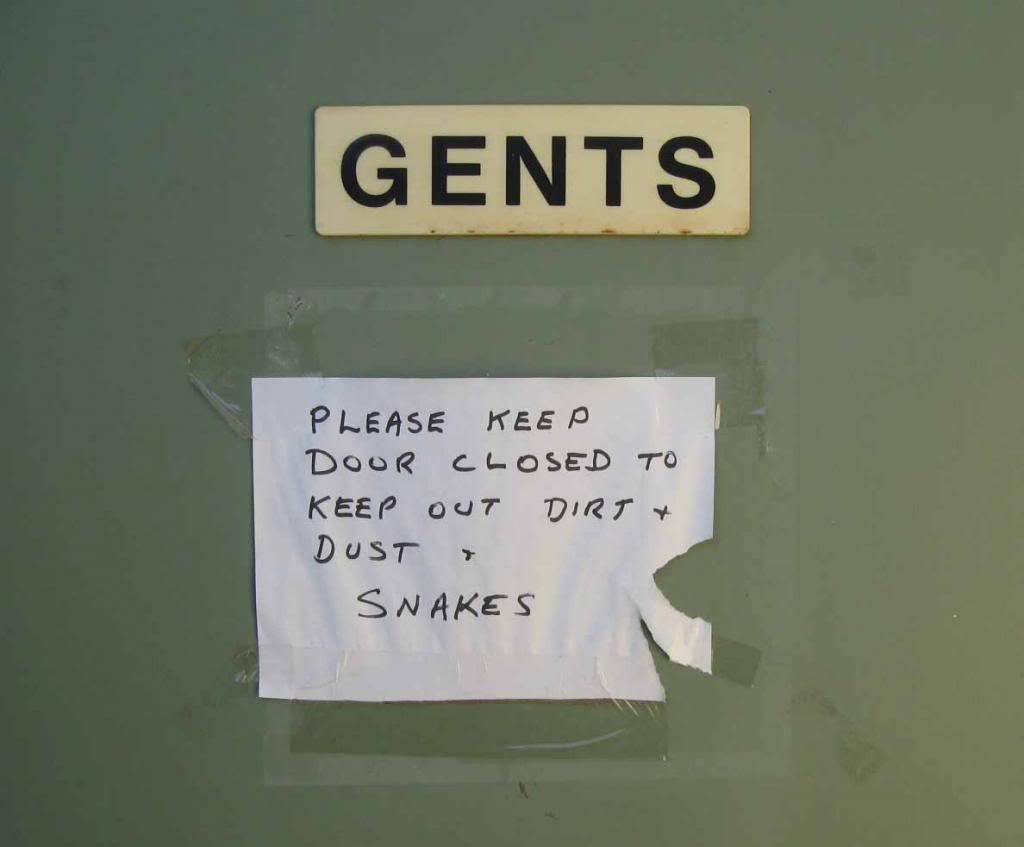
Tuena was a gold-rush town and produced a lot of gold in the 1850's, but now is just a dot on the map with one shop, a pub, three Churches and about 200 people.

It is still producing gold on a small scale and is one of the places our Prospecting Club visits regularly as it is only about four hours drive from home.
There are old diggings in many areas that are good for detecting, and the creek will yield gold in every panful. And we found a bit of gold here and there, a few small nuggets, but not enough to boast about.
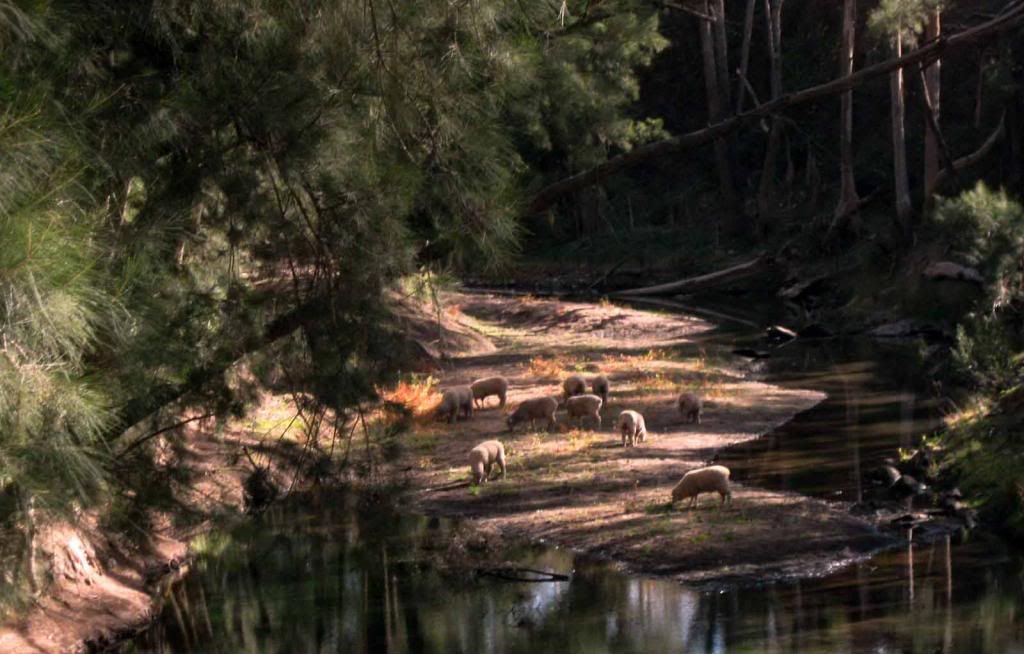
It's a hard life out here but somehow Robyn and Lyn struggle on.

Here's Lyn getting a bit of colour.
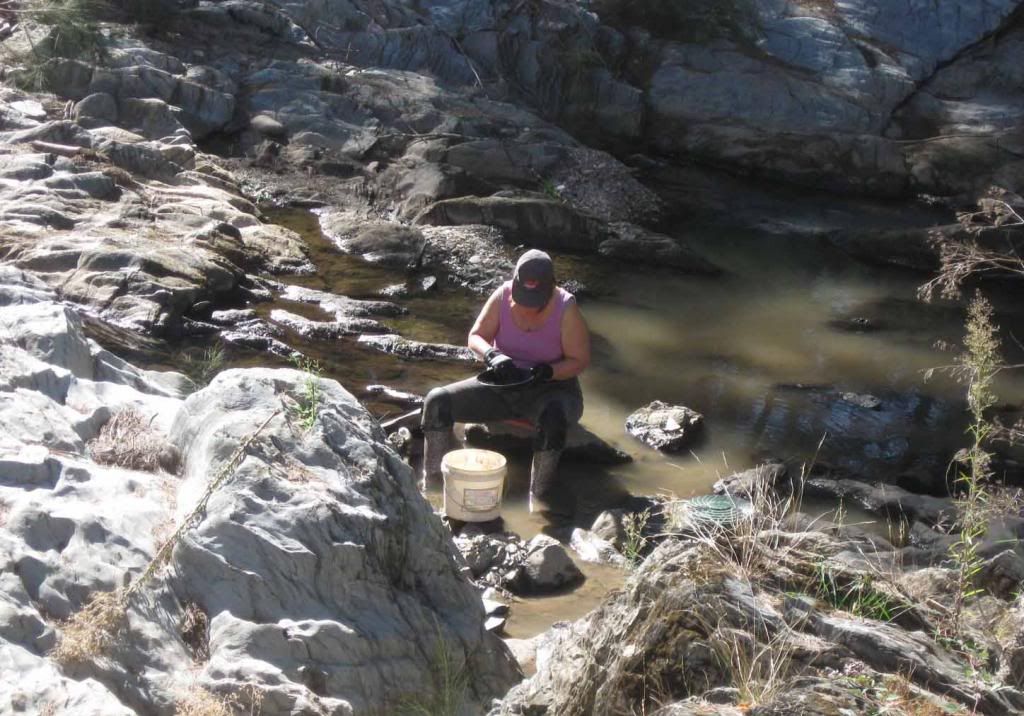
My sister-in-law Lyn, our regular companion and loving sister, comes on most of our trips. However she had to go home for about a week or so and we therefore decided to move to a new spot that was even closer to home.
HILL END
We set off for Hill End, a town very famous in Australian history and, in particular, in the history of gold in Oz. Here the world-famous Holtermann Nugget was found by a German immigrant Bernhardt Otto Holtermann.
The nugget was 59 inches tall (1.5 metres) and weighed 630 pound (286 kg) with about 5000 ounces of gold. Here it is ...
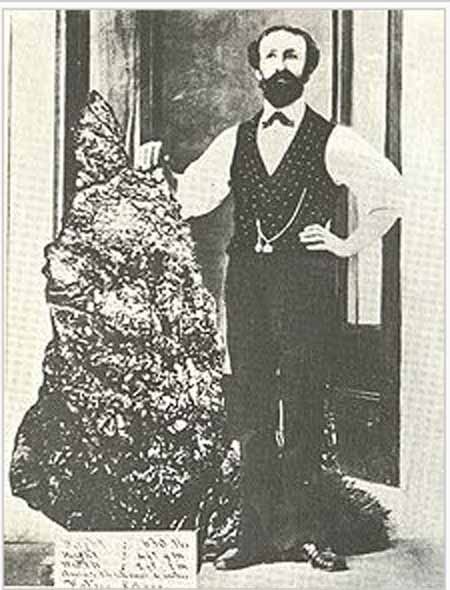
Hill End has a caravan park a bit better than primitive but remains fairly basic with two showers and toilets, but not much else. The township is a bit of a ghost town with the inevitable pub, two shops, two Churches and ... well that about exhausts the towns facilities.
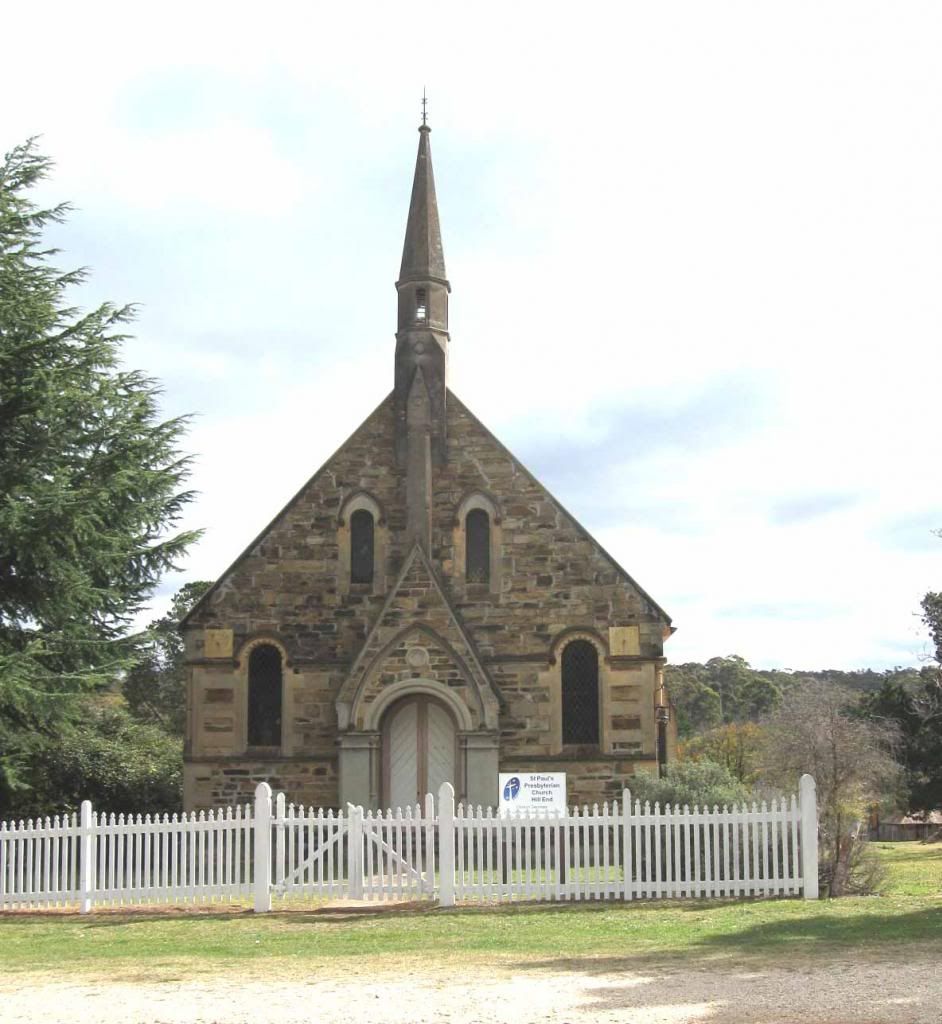
This is St Paul's Presbyterian Church that meet here once a month. We missed out not being there in the right week.
Here is one of the shops.
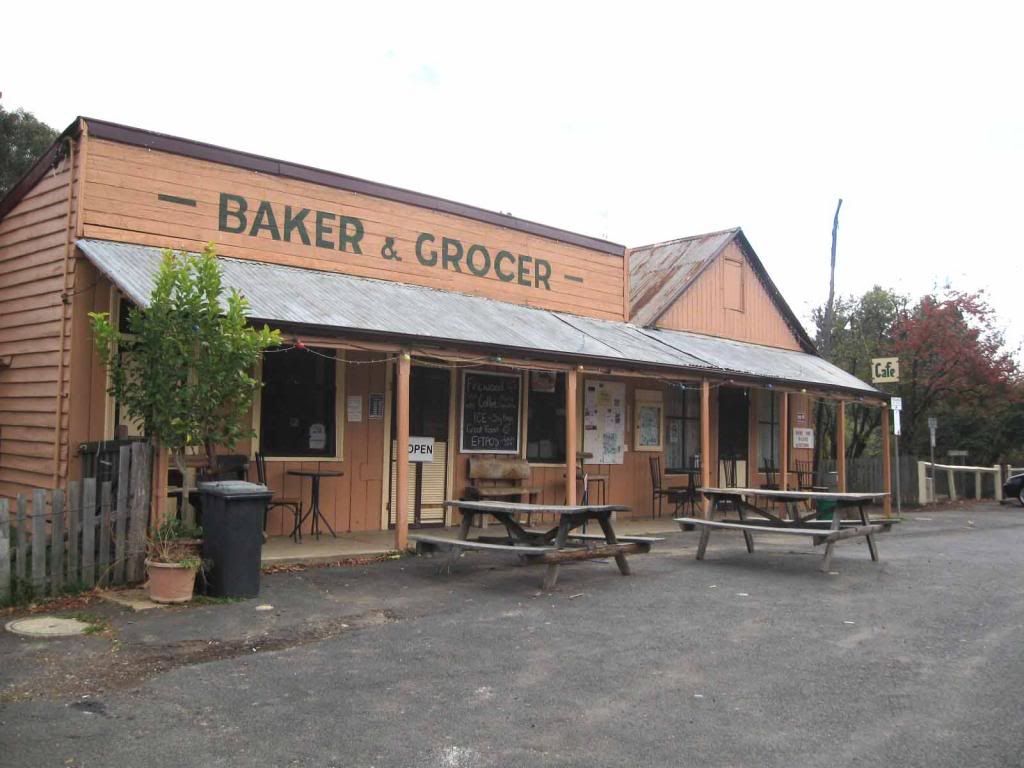
It boasts of being a Baker's Shop and it is, provided
1: you want bread only on Thursday,
2: you are there early and
3: you are blessed with a bit of luck and have a strong following wind.
With all that in your favour you just may get some before it's all gone. And I hasten to assure you that it is two and a half times the price that we pay at home.
WHERE HILL END SHINES
Hill End does one thing very well. It does give very good information about the towns history with pictures and displays dotted all over the old village. Most of the old buildings are long gone, but a large quantity of pictures of the original town survive.
A local man, with the grand name of Beaufoy Merlin, was an expert photographer back in the gold-rush days. He took pictures of just about everything in this district and, by some miracle, they still survive.
So, as you walk down the streets you see signs just like this one.

This tells you that the Oddfellows Ball was held in the building that use to stand right on this piece of land. There, right before you, is a picture of the old building and some info about it.
These pictures/signs are everywhere in the three major streets and so you are able to get quite a good understanding of the old town.
Here are two of them.
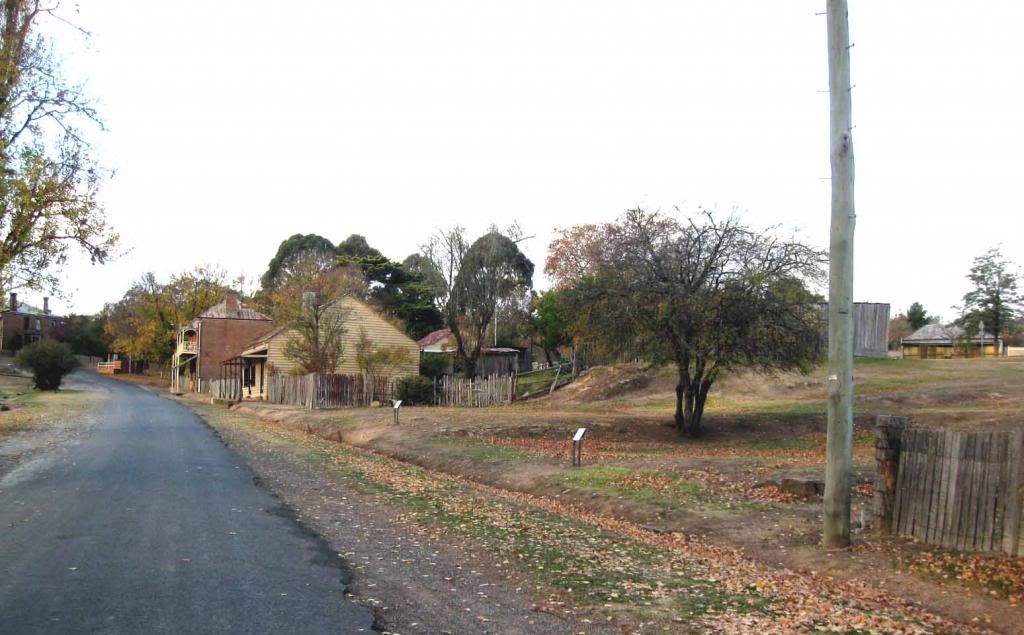
Some of the old Miner's Homes survive and are still occupied.
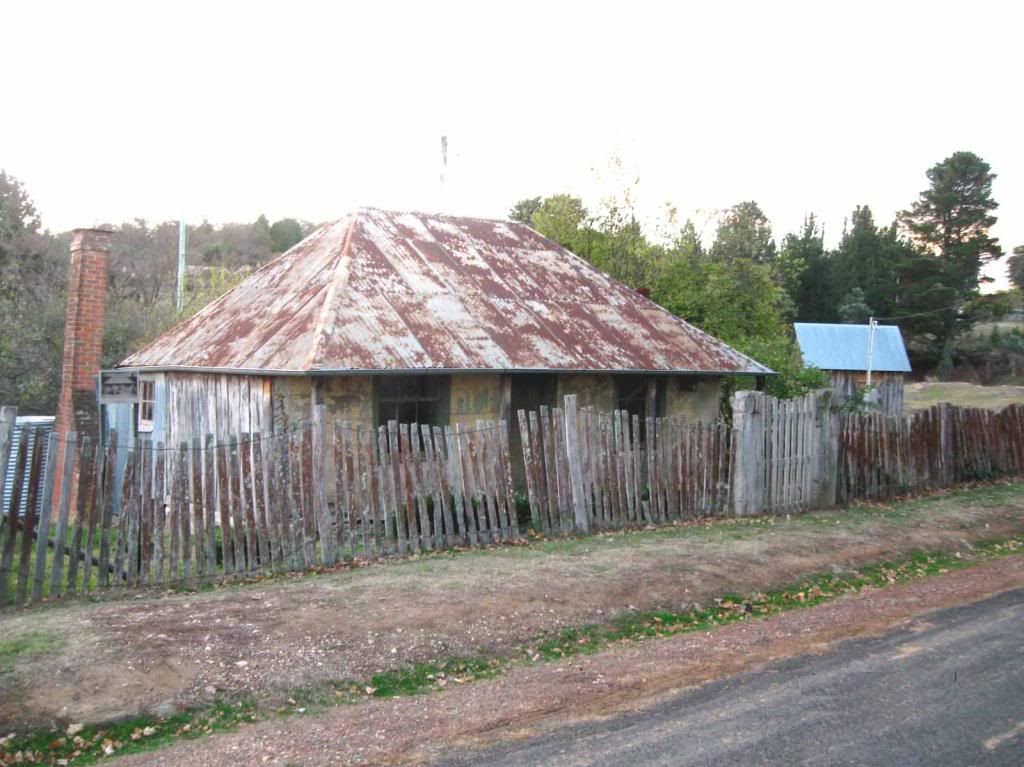
When Bernhardt Holtermann found his fortune in Hill End he was sensible enough to hang onto it. Many others who also "struck it lucky" were penniless just a few years later. Holtermann was very enterprising and, amongst many other endeavours, he built this little shopping centre.
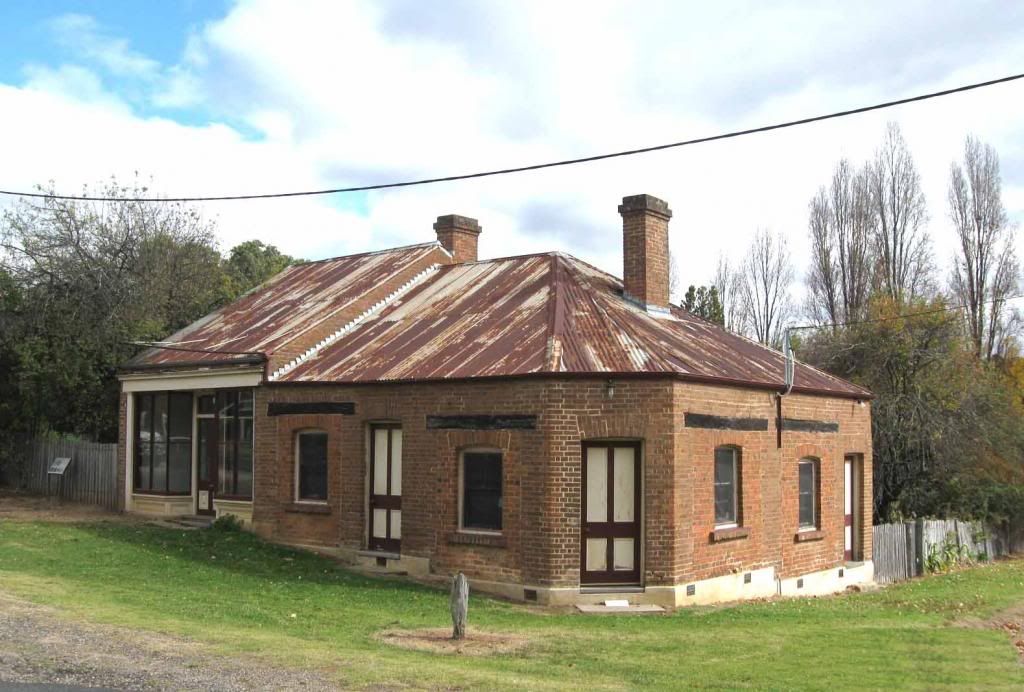
We bought a few items in that shop on an earlier trip to Hill End but it is shut now.
The following photograph is one I took of the street signs mentioned earlier. It presents a collage of Beaufoy Merlin's pictures of the same shops taken in the 1870's. To my way of looking at it these old pictures breathe life into Hill End today revealing some of the old-timers standing around this very building way back then.
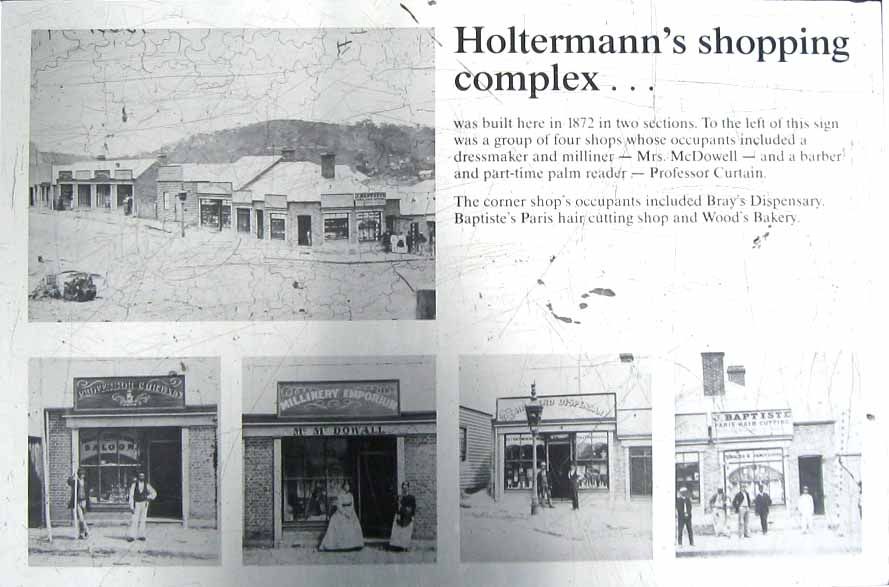
RELICS
There are relics of the old mining days as well. Out of the town a few miles you can find these old ovens. They were built by the Cornish miners then living at Hill End.

The ovens were used to "cook" the gold-bearing quartz in order to make it easier to crush. In a way it "softened" the quartz.
The softened quartz was then crushed by the stamper.
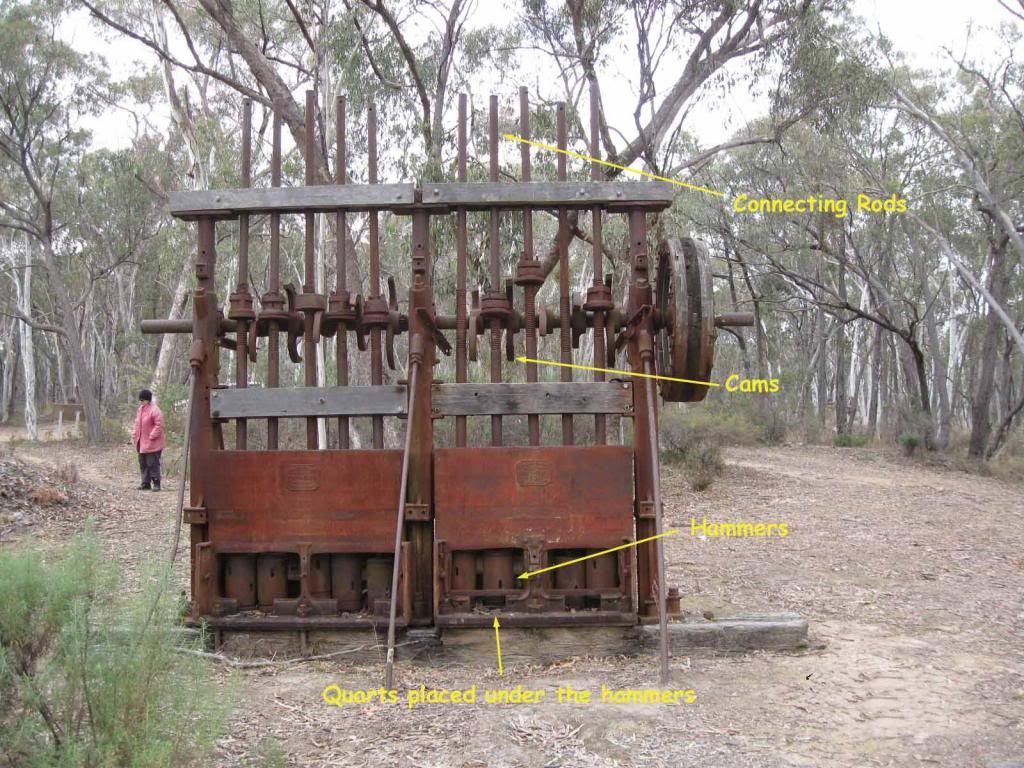
The stamper was steam driven with a flat belt drive operating on the pulley. As it revolved it caused the cams to lift the connecting rods to the top. At that point the cam released the rod and it fell allowing the very heavy hammers on the ends of the connecting rods to crush into the quartz below and crush it.
The whole operation was extremely noisy and people lived almost right next to them. They operated day and night and deafness must have been the result for many.
This particular stamper is well out of town, but there were many in the main street situated right next to the hotels that were home to so many.
That will have to do for now and thanks for reading this little episode.
Here was the problem. Our three-way fridge runs on gas, electricity and also from the car battery when travelling. We purchased $300 of perishables, put them in the freezer, and drove to our planned campsite. There we discovered that the gas part of the fridge had died rather suddenly.
We do have a Honda generator and we started that up whilst the fridge doctor (that's me) examined the patient. No pulse, no spark of life, so no luck there. So we reluctantly had to leave the bush and go to a caravan park so that we could plug into power and quite literally "save our bacon" and all the other perishable food. That was a bad start to our little adventure.
TUENA
So here we are in the caravan park in a nice little place called Tuena.

The caravan park is at best called "basic." Less gracious people could perhaps say it is "primitive". However it has power points available in a few spots and that's what we needed. About 100 yards away there are two showers and one toilet.

Tuena was a gold-rush town and produced a lot of gold in the 1850's, but now is just a dot on the map with one shop, a pub, three Churches and about 200 people.

It is still producing gold on a small scale and is one of the places our Prospecting Club visits regularly as it is only about four hours drive from home.
There are old diggings in many areas that are good for detecting, and the creek will yield gold in every panful. And we found a bit of gold here and there, a few small nuggets, but not enough to boast about.

It's a hard life out here but somehow Robyn and Lyn struggle on.

Here's Lyn getting a bit of colour.

My sister-in-law Lyn, our regular companion and loving sister, comes on most of our trips. However she had to go home for about a week or so and we therefore decided to move to a new spot that was even closer to home.
HILL END
We set off for Hill End, a town very famous in Australian history and, in particular, in the history of gold in Oz. Here the world-famous Holtermann Nugget was found by a German immigrant Bernhardt Otto Holtermann.
The nugget was 59 inches tall (1.5 metres) and weighed 630 pound (286 kg) with about 5000 ounces of gold. Here it is ...

Hill End has a caravan park a bit better than primitive but remains fairly basic with two showers and toilets, but not much else. The township is a bit of a ghost town with the inevitable pub, two shops, two Churches and ... well that about exhausts the towns facilities.

This is St Paul's Presbyterian Church that meet here once a month. We missed out not being there in the right week.
Here is one of the shops.

It boasts of being a Baker's Shop and it is, provided
1: you want bread only on Thursday,
2: you are there early and
3: you are blessed with a bit of luck and have a strong following wind.
With all that in your favour you just may get some before it's all gone. And I hasten to assure you that it is two and a half times the price that we pay at home.
WHERE HILL END SHINES
Hill End does one thing very well. It does give very good information about the towns history with pictures and displays dotted all over the old village. Most of the old buildings are long gone, but a large quantity of pictures of the original town survive.
A local man, with the grand name of Beaufoy Merlin, was an expert photographer back in the gold-rush days. He took pictures of just about everything in this district and, by some miracle, they still survive.
So, as you walk down the streets you see signs just like this one.

This tells you that the Oddfellows Ball was held in the building that use to stand right on this piece of land. There, right before you, is a picture of the old building and some info about it.
These pictures/signs are everywhere in the three major streets and so you are able to get quite a good understanding of the old town.
Here are two of them.

Some of the old Miner's Homes survive and are still occupied.

When Bernhardt Holtermann found his fortune in Hill End he was sensible enough to hang onto it. Many others who also "struck it lucky" were penniless just a few years later. Holtermann was very enterprising and, amongst many other endeavours, he built this little shopping centre.

We bought a few items in that shop on an earlier trip to Hill End but it is shut now.
The following photograph is one I took of the street signs mentioned earlier. It presents a collage of Beaufoy Merlin's pictures of the same shops taken in the 1870's. To my way of looking at it these old pictures breathe life into Hill End today revealing some of the old-timers standing around this very building way back then.

RELICS
There are relics of the old mining days as well. Out of the town a few miles you can find these old ovens. They were built by the Cornish miners then living at Hill End.

The ovens were used to "cook" the gold-bearing quartz in order to make it easier to crush. In a way it "softened" the quartz.
The softened quartz was then crushed by the stamper.

The stamper was steam driven with a flat belt drive operating on the pulley. As it revolved it caused the cams to lift the connecting rods to the top. At that point the cam released the rod and it fell allowing the very heavy hammers on the ends of the connecting rods to crush into the quartz below and crush it.
The whole operation was extremely noisy and people lived almost right next to them. They operated day and night and deafness must have been the result for many.
This particular stamper is well out of town, but there were many in the main street situated right next to the hotels that were home to so many.
That will have to do for now and thanks for reading this little episode.
